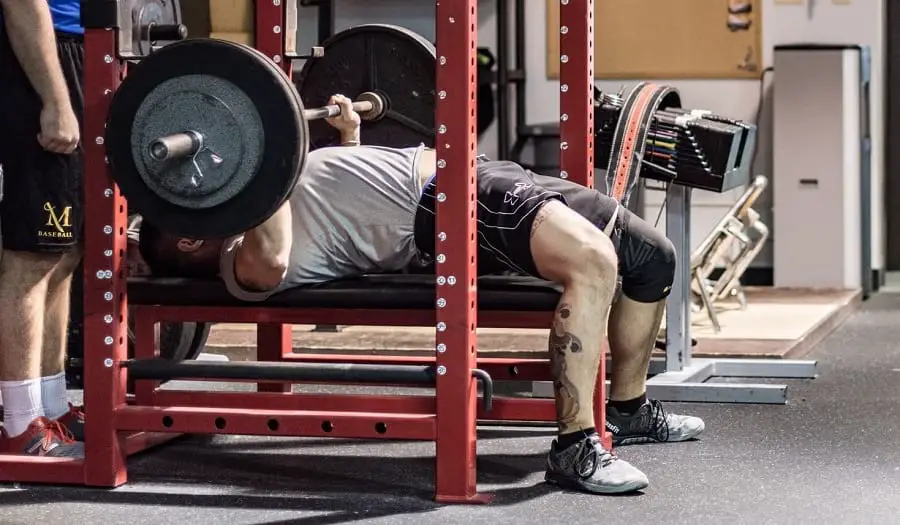
Practice Your Bench Press Form and Save Your Shoulders
Bench pressing is a great compound lift and should be included into every lifters routine. But to receive the most benefits out of this exercise you must ensure you’re using proper form (have your bench press technique down). There’s nothing worse than looking over at the gym and seeing sloppy bench press technique.
The bench press is one of the exercises that works very well with progressive overload since such a large recruitment of muscle fibers is involved keep increasing the weight you lift by 5-10 pounds every time you hit the amount of reps and sets your aiming for.
Few people understand that your back strength also plays an important role for heavy benching since it is mostly your back that will keep you tight and stable. So if you have been neglecting your back stop and start adding rows, pull ups / pull downs and I bet your benching numbers will start to rise.
Like most compound exercises it is best to perform this exercise inside of a power rack to help ensure your safety. Many power racks also help prevent dropped weights from rolling into another area. This helps to keep everyone in the gym more safe and if you do have to bail on your lift you know nobody is going to want rip your head off from being hit by your runaway weights.
How to Perform the Bench Press Exercise
- 1) The bar should move diagonally from your mid chest to directly over your shoulders. This ensures the entire arm is under the bar to support it.
- 2) Grip the bar as tight as possible
- 3) Your elbows should be tucked at 75 degrees and not 90 to help minimize the chance of a shoulder damage.
- 4) Have your shoulders pulled back (pushing your chest out), and push your upper back into the bench
- 5) Slightly arch tour back making sure your shoulder and but stay touching the bench at all times. Keeping an arch in your back helps your spine stay in a neutral position.
- 6) Keep your entire body tight with your feet pulled under the bench as close to your but as you can with your feet still flat on the floor (no tippy toes) giving traction.
How to Explination
Grip the bar as tight as possible, this will recruit more muscle fibers giving you more power for your lockout. Another method to help with lockout is working your triceps as lockout is heavily dependent on triceps strength as well.
Lift the bar from the rack place directly over the shoulders with your arms locked in, this is the starting position. Breathe in and begin coming down slowly until the bar touches your mid chest (don’t forget to move the bar diagonally from above the shoulders to the mid chest).
The lowering of the bar should be a controlled movement taking approx. 2 to 3 seconds, breath in during the lowering phase. Stop and pause when the bar touches your chest to prevent using momentum for the lifting of the bar. Lifting heavier by bouncing the bar off of your chest doesn’t impress people and sets you up for injury. Don’t forget when lifting to check your ego at the door and always build up to heavier weights with proper form. This will allow you to bench press more weight down the road with a lot less risk of injury.
If you are trying to increase your starting strength you should focus on using bottom half reps. What are bottom half reps? Well start with the weight as close to your chest as the benching station will allow. Lift the bar as you normally would but at half way through your lift pause for 2 seconds and then slowly lower the weight back toward your chest. At your chest you should pause for another 2 seconds and repeat. Use a moderate weight to allow a minimum of 4 reps to a maximum of 12 reps.
Benching Variations to Try
Well regular flat bench press is a great exercise here are some alternate bench press types for you to try
- 1) Close grip bench press
- 2) Chambered bar bench press
- 3) Incline bench press
- 4) Decline bench press
- 5) Heavy dumbbell press
- 6) Floor presses
- 7) Benching with pause
- 8) Slow benching (Take how long it takes to lower and lift for one rep then double or triple the lifting time by pressing slower)
- 9) Speed benching
Stay watching our blog as we will go through each of these variations in future posts.
Looking to gain more strength or lose some weight? We offer free fitness tools to help you reach your fitness goals. Register for free while we are in beta and get free lifetime access to our fitness tools that include an easy to use Calorie Counter, High-Intensity Interval Timer, Multiple Fitness Calculators and our Exercise Logger.